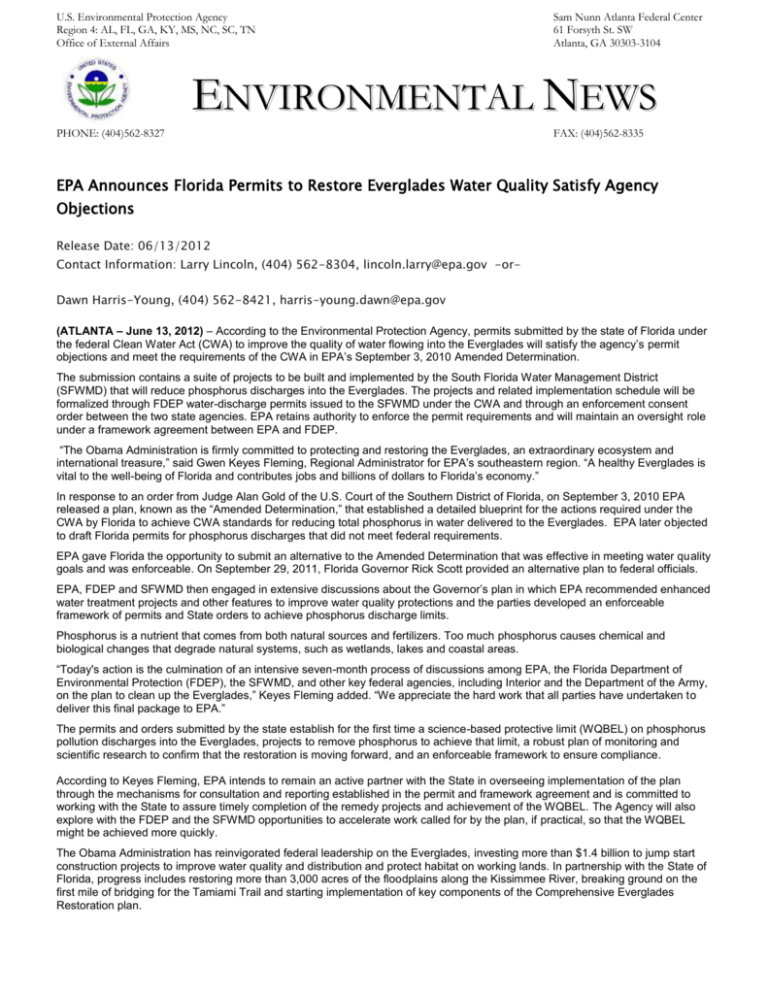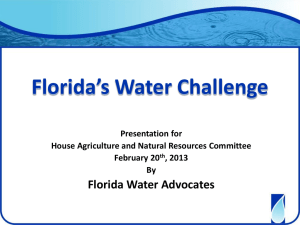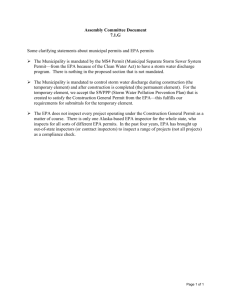Everglades Press Rel..
advertisement

U.S. Environmental Protection Agency Region 4: AL, FL, GA, KY, MS, NC, SC, TN Office of External Affairs Sam Nunn Atlanta Federal Center 61 Forsyth St. SW Atlanta, GA 30303-3104 ENVIRONMENTAL NEWS PHONE: (404)562-8327 FAX: (404)562-8335 EPA Announces Florida Permits to Restore Everglades Water Quality Satisfy Agency Objections Release Date: 06/13/2012 Contact Information: Larry Lincoln, (404) 562-8304, lincoln.larry@epa.gov -orDawn Harris-Young, (404) 562-8421, harris-young.dawn@epa.gov (ATLANTA – June 13, 2012) – According to the Environmental Protection Agency, permits submitted by the state of Florida under the federal Clean Water Act (CWA) to improve the quality of water flowing into the Everglades will satisfy the agency’s permit objections and meet the requirements of the CWA in EPA’s September 3, 2010 Amended Determination. The submission contains a suite of projects to be built and implemented by the South Florida Water Management District (SFWMD) that will reduce phosphorus discharges into the Everglades. The projects and related implementation schedule will be formalized through FDEP water-discharge permits issued to the SFWMD under the CWA and through an enforcement consent order between the two state agencies. EPA retains authority to enforce the permit requirements and will maintain an oversight role under a framework agreement between EPA and FDEP. “The Obama Administration is firmly committed to protecting and restoring the Everglades, an extraordinary ecosystem and international treasure,” said Gwen Keyes Fleming, Regional Administrator for EPA’s southeastern region. “A healthy Everglades is vital to the well-being of Florida and contributes jobs and billions of dollars to Florida’s economy.” In response to an order from Judge Alan Gold of the U.S. Court of the Southern District of Florida, on September 3, 2010 EPA released a plan, known as the “Amended Determination,” that established a detailed blueprint for the actions required under the CWA by Florida to achieve CWA standards for reducing total phosphorus in water delivered to the Everglades. EPA later objected to draft Florida permits for phosphorus discharges that did not meet federal requirements. EPA gave Florida the opportunity to submit an alternative to the Amended Determination that was effective in meeting water quality goals and was enforceable. On September 29, 2011, Florida Governor Rick Scott provided an alternative plan to federal officials. EPA, FDEP and SFWMD then engaged in extensive discussions about the Governor’s plan in which EPA recommended enhanced water treatment projects and other features to improve water quality protections and the parties developed an enforceable framework of permits and State orders to achieve phosphorus discharge limits. Phosphorus is a nutrient that comes from both natural sources and fertilizers. Too much phosphorus causes chemical and biological changes that degrade natural systems, such as wetlands, lakes and coastal areas. “Today's action is the culmination of an intensive seven-month process of discussions among EPA, the Florida Department of Environmental Protection (FDEP), the SFWMD, and other key federal agencies, including Interior and the Department of the Army, on the plan to clean up the Everglades,” Keyes Fleming added. “We appreciate the hard work that all parties have undertaken to deliver this final package to EPA.” The permits and orders submitted by the state establish for the first time a science-based protective limit (WQBEL) on phosphorus pollution discharges into the Everglades, projects to remove phosphorus to achieve that limit, a robust plan of monitoring and scientific research to confirm that the restoration is moving forward, and an enforceable framework to ensure compliance. According to Keyes Fleming, EPA intends to remain an active partner with the State in overseeing implementation of the plan through the mechanisms for consultation and reporting established in the permit and framework agreement and is committed to working with the State to assure timely completion of the remedy projects and achievement of the WQBEL. The Agency will also explore with the FDEP and the SFWMD opportunities to accelerate work called for by the plan, if practical, so that the WQBEL might be achieved more quickly. The Obama Administration has reinvigorated federal leadership on the Everglades, investing more than $1.4 billion to jump start construction projects to improve water quality and distribution and protect habitat on working lands. In partnership with the State of Florida, progress includes restoring more than 3,000 acres of the floodplains along the Kissimmee River, breaking ground on the first mile of bridging for the Tamiami Trail and starting implementation of key components of the Comprehensive Everglades Restoration plan. The water quality projects to be undertaken by the State complement these efforts and represent a critical additional step toward Everglades restoration. They include a significant expansion of wetland treatment systems that filter and clean the water before release, and new components, called Flow Equalization Basins (FEBs), that will store and slowly release water to the wetland treatment systems (known as Stormwater Treatment Areas or STAs). There are currently about 60,000 acres of these marsh treatment systems already in place or under construction. The plan identifies another 6,500 acres of STAs and approximately 110,000 acre-feet of water storage on approximately 19,000 acres of FEBs dedicated to provide clean water for the Everglades. To view EPA documents relating to this release go to: http://www.epa.gov/aboutepa/states/fl.html To view State of Florida documents go to: http://depnewsroom.wordpress.com/hot-topics/everglades/ ###








